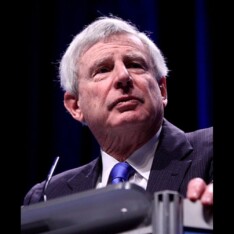Big-Government Welfare Crowds Out Beneficial Social Behavior

Many of the most important and serious conservative intellectuals today seem to have concluded that criticizing national government welfare policy spending is no longer worth the cost of being considered miserly, uncharitable, and even immoral. But what if that social policy is not only economically wasteful but is actually the major cause of suppressing productive employment, community social order, and stable family life in the US?
Reflecting upon why charitable volunteering had declined so dramatically in recent years, a large rescue mission’s executive director mused: “When your elderly next-door neighbor has a cupboard full of government-subsidized food, you are certainly less likely to volunteer preparing him a meal.” When a single mother receives welfare benefits that exceed $12 per hour, she is less likely to show up at a dress-for-job interview session, “and so are the volunteers who run it.” He concluded: “America is not losing compassion. It is just being crowded out.”
In his 1988 classic In Pursuit of Happiness, political scientist Charles Murray had explained social “crowding out” in more academic terms. Citing America’s iconic early foreign observer Alexis de Tocqueville, he noted that America had long been known for relying on volunteers and communities rather than government to promote social welfare. Subsequent Census data showed that the richer the United States became, the greater the proportion of its wealth that was devoted to philanthropy. “Then, suddenly,” Murray noted, “sometime during 1964–65, in the middle of an economic boom, this consistent trend was reversed.”
Murray identified a “causal relationship” in explaining that decline as resulting from the mass increase in national government spending under Lyndon Johnson’s “Great Society” welfare programs. With generous benefits to the needy, why would the average taxpayer not say, “I pay my taxes and the government uses it for welfare so why should I contribute to charity?” That “government spending crowds out private philanthropy,” he argued, “has been demonstrated in a number of technical analyses,” which he cited and explained. Ronald Reagan (and later Bill Clinton) work requirements did provide some mitigation of the crowding out effects. But relatively unrestricted welfare crowding out exploded again under George W. Bush, Barack Obama, Donald Trump, and Joe Biden.
The idea of crowding out has had a history going back to Lord Keynes in but with a narrower economic focus on monetary borrowing. Yet, as Mercatus Center economists Matthew D. Mitchell and Jakina R. Debnam have noted, taxation can have a similar effect in the sense that “Capital used by the government is capital that cannot be used by private business,” including charities. The effect is clearest for loans. “As the government borrows, competition in the market for loanable funds increases, raising the price of borrowing, or the interest rate, for private investors. For firms, this means an increase in the cost of doing business,” crowding out “companies and projects that would have otherwise been profitable” with a lower interest rate.
As far as taxes and spending, Mitchell and Debnam note that for the period prior to the 2008 Great Recession, European economists Andrew Mountford and Harold Uhlig had calculated that “a 2 percent increase in government spending will—under the best scenario—lead to a less than 2 percent increase in GDP in the short-run.” But eventually, “the tax increases needed to finance this spending will result in a more than 7 percent contraction in GDP.” The Congressional Budget Office estimated that that such crowding out would “reduce inflation-adjusted gross domestic product per person by 6 percent in 2025 and by 15 percent in 2035,” a $1.2 trillion loss that could not be used for individual, market, or charitable purposes.
Economist James L. Caton noted that by 2021 Federal Reserve Quantitative Easing had led the Fed to park significant government deficit spending into its private balance accounts rather than selling bonds into the market. Analyzing the available data comparing private AAA-rated bonds and the Fed funds rate, Caton found that keeping new money out of the financial system allowed the Fed to keep its federal funds rate artificially lower than otherwise, giving it an advantage over private rates, “meaning that public [government] borrowing becomes relatively cheaper,” crowding out lending for private businesses and charities.
While economic effects are indirect, social policy directly crowds out independent private benevolence. A study of charitable giving to major organizations by academics James Andreoni and A. Abigail Payne found that government grants to charities result in significant reductions in private charitable fund-raising. This is mainly because these institutions become satisfied afterwards with the new higher government-supported income levels, while private soliciting is only offset in a minor way by new individual contributions attracted by the government’s support of the organization.
In a more extensive study, Andreoni and Payne analyzed government grants and results data “on more than 8,000 charities operating in the United States. We measure an overall level of crowding out of about 75 percent: private donations fall by about three quarters of the amount of government grants.” Apparently, the “the bulk of the crowding out, 70 percent, is due to a change in fundraising” administration rather than direct individual refusals to contribute.
But the most socially destructive crowding out is from so-called “means-tested” welfare that directly subsidizes underemployment, family break-up, and idle-male community disorder. Demographic expert Nicholas Eberstadt has long provided the data showing the consequences of this growth of the entitlement state. In pre-Great Society 1964, merely seven percent of US infants were born outside wedlock; today it is over 40 percent. Only 3 percent of healthy adult men were unemployed then; today that has more than doubled. National means-tested welfare spending increased from five percent of GNP in 1961 to 18.8 in 1983 to about double that today.
More important, as Eberstadt showed,
By 2012, there was no longer any readily observable correspondence between the officially designated condition of poverty and the recipience of ‘anti-poverty’ entitlements. In that year, the number of people taking home means-tested benefits was more than twice the number of those living below the poverty line — meaning a decisive majority of recipients of such aid were the non-poor.
And they were not necessarily the deserving non-poor:
mass gaming of the welfare system appears to be a fact of modern American life. The country’s ballooning “disability” claims attest to this. Disability awards are a key source of financial support for non-working men now, and disability judgments also serve as a gateway to qualifying for a whole assortment of subsidiary welfare benefits. Successful claims by working-age adults against the Social Security Disability Insurance (SSDI) program rose almost six-fold between 1970 and 2012 — and that number does not include claims against other major government disability programs, such as SSI. There has never been a serious official effort to audit SSDI — or, for that matter, virtually any of the country’s current entitlement programs.
Generous COVID-era payments increased these patterns helping crowd out 64 million households from productive work with $25,000 grants helping pay for early retirements. If pre-COVID employment rates had continued into 2022, almost 3 million additional workers would have been in the labor force.
Eberstadt noted that the late Democratic Senator Daniel Patrick Moynihan had wisely warned that “It cannot too often be stated that the issue of welfare is not what it costs those who provide it, but what it costs those who receive it.” Means tested welfare necessarily crowds out the poor from productive employment by substituting government grants for family earning and community support. Over time, those who receive benefits tend to become entrapped by what seems easy money coming in. But becoming dependent, they find it difficult to move back from easy money to obtain the positive but more difficult benefits of jobs, marriage, and association.
A Brookings Institute study found that the “poverty rate among families with children could be lowered by 71 percent if the poor completed high school, worked full-time, married, and had no more than two children.” It found that one “would have to triple welfare benefits before they reduce poverty as much as any of the behavioral changes. Work, marriage, education, and family size are all more powerful determinants of the incidence of poverty than the amount of cash assistance received from the government.” Effective reforms limiting non-disability welfare or rewarding work are all but gone today and, Eberstadt added, there is even little serious effort by the nationalized welfare bureaucracy to enforce any restrictions other than their own protective bureaucratic rules.
Murray explained that the more policy moves away from centralized bureaucracy and towards real people in communities, the more common sense and willingness to help a neighbor. Indeed, worldwide data show that the US is the most proportionately generous as charitable contributors, and perhaps as volunteers too, of any nation. But neighbors also tend to understand that jobs are better than the unemployment line, the family better than hook-ups, and communities better than gangs. More balanced welfare belongs back in neighborhoods even more than economic activity belongs in markets.
There are in fact many local solutions and Reagan even tried to send all welfare to the states to force the Feds to concentrate on fiscally endangered entitlements like Social Security and Medicare. The way back from today’s welfare induced crisis is to tailor real local needs to real local communities. And for Washington to repair the entitlement crisis it created.
Maybe those old Constitutional Founders knew something when they made local and state federalism the first social priority and national power utilized only as a limited last resort.











